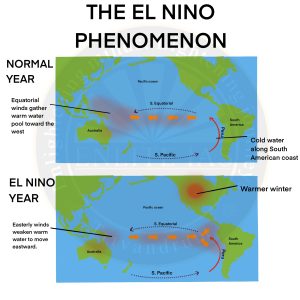Why in the news?
- A new study published in the Science journal showed that heavy downpours of over 50% are more likely in India during the El Nino period.
El Nino
- What is it?: El Niño (meaning “the little boy” in Spanish) is a climate pattern that describes the unusual warming of surface waters in the eastern Pacific Ocean.
- Causes:
- During an El Niño event, the Sea Surface Temperatures (SST) in the equatorial Pacific Ocean off the northern coast of South America became at least 0.5 degrees Celsius warmer than the long-term average.
- During El Niño, a warm ocean current replaces the cold Humboldt current on the Peruvian coast.
- The El Niño event is not a regular cycle, they are not predictable and occur irregularly at two- to seven-year intervals.
- Effects
- El Niño can affect weather worldwide – Generally resulting in warmer temperatures and less rainfall than normal in many regions of the world, including India.
- El Niño results in the rise of sea surface temperatures.
- It also weakens the trade winds of the affected region.
- In India and Australia, it can affect monsoon rainfall and bring about drought conditions. This affects crop productivity largely.
- It has been also observed at certain times, that El Niño may not bring drought but cause heavy rainfall due to the influence of factors like positive Indian Ocean Dipole (IOD).

